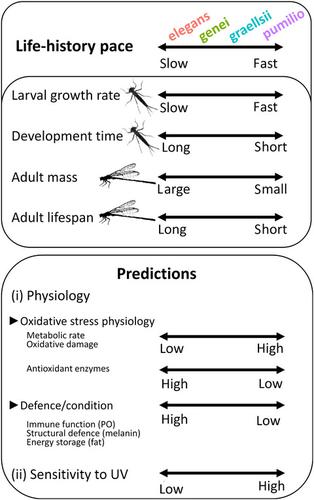当前位置:
X-MOL 学术
›
J. Anim. Ecol.
›
论文详情
Our official English website, www.x-mol.net, welcomes your
feedback! (Note: you will need to create a separate account there.)
Strong species differences in life history do not predict oxidative stress physiology or sensitivity to an environmental oxidant
Journal of Animal Ecology ( IF 3.5 ) Pub Date : 2020-04-28 , DOI: 10.1111/1365-2656.13235 Nedim Tüzün 1 , Sara Debecker 1 , Robby Stoks 1
Journal of Animal Ecology ( IF 3.5 ) Pub Date : 2020-04-28 , DOI: 10.1111/1365-2656.13235 Nedim Tüzün 1 , Sara Debecker 1 , Robby Stoks 1
Affiliation

|
Species typically align along a fast-slow life-history continuum, yet it is not clear to what extent oxidative stress physiology can be integrated with this continuum to form a 'pace-of-life syndrome', especially so in invertebrates. This is important, given the assumed role of oxidative stress in mediating life-history trade-offs, and the prediction that species with a faster pace should be more vulnerable to oxidative stress. We tested whether a species' life-history pace, here represented by its growth rate, can predict species-level differentiation in physiology and sensitivity to oxidative stress. Therefore, we exposed four species of Ischnura damselflies that strongly align along a fast-slow life-history continuum to different levels of ultraviolet (UV) radiation. We measured an extended set of physiological traits linked to the pace-of-life: standard metabolic rate (SMR), oxidative stress physiology (antioxidant enzymes and oxidative damage), and defence/condition traits (investment in immune function, energy storage, and structural defence). Despite strong species differences in growth rate and physiology, growth rate did not predict species-level differentiation in physiology. Hence there was no support for the integration of metabolic rate, oxidative stress physiology or defence/condition traits into a species-level syndrome. UV exposure affected nearly all traits: it reduced growth rate and increased metabolic rate, affected all oxidative stress physiology traits and increased the two defence traits (immune function, and melanin content). Nevertheless, the pace-of-life based on growth rate did not predict sensitivity to UV. Instead, the observed pattern of investment in structural UV defence (melanin) might have reduced the need for enzymatic antioxidant defence, this way potentially decoupling the covariation between the life-history pace and oxidative stress physiology. The absence of an integrated axis of life-history and physiological variation indicates no major constraints for the evolution of these traits among the studied damselfly species. Our study highlights that ecological differences between species may decouple covariation between species' life-history pace and their physiology, as well as their sensitivity to environmental stressors.
中文翻译:

生活史中的强烈物种差异并不能预测氧化应激生理学或对环境氧化剂的敏感性
物种通常沿着快-慢的生活史连续体排列,但目前尚不清楚氧化应激生理学可以在多大程度上与该连续体结合以形成“生活节奏综合症”,尤其是在无脊椎动物中。考虑到氧化应激在调节生命史权衡中的假定作用,以及预测速度较快的物种应该更容易受到氧化应激的影响,这一点很重要。我们测试了一个物种的生活史步调(这里以它的生长速度表示)是否可以预测物种水平的生理差异和对氧化应激的敏感性。因此,我们将四种 Ischnura 豆娘暴露在不同水平的紫外线 (UV) 辐射下,它们沿着快-慢的生活史连续体强烈排列。我们测量了一系列与生活节奏相关的生理特征:标准代谢率 (SMR)、氧化应激生理学(抗氧化酶和氧化损伤)和防御/状况特征(对免疫功能、能量储存和结构防御)。尽管生长速率和生理学上的物种差异很大,但生长速率并不能预测生理学上的物种水平分化。因此,不支持将代谢率、氧化应激生理学或防御/状况特征整合到物种水平的综合征中。紫外线照射几乎影响了所有性状:它降低了生长速度和增加了代谢率,影响了所有氧化应激生理性状并增加了两种防御性状(免疫功能和黑色素含量)。尽管如此,基于增长率的生活节奏并不能预测对紫外线的敏感性。相反,观察到的对结构性紫外线防御(黑色素)的投资模式可能减少了对酶促抗氧化防御的需求,这种方式可能使生活史步调和氧化应激生理学之间的协变脱钩。缺乏生活史和生理变化的综合轴表明,在所研究的豆娘物种中,这些性状的进化没有重大限制。我们的研究强调,物种之间的生态差异可能会使物种的生活史步伐与其生理机能以及它们对环境压力因素的敏感性之间的协变脱钩。观察到的对结构性紫外线防御(黑色素)的投资模式可能减少了对酶促抗氧化防御的需求,这种方式可能会解耦生活史步调和氧化应激生理学之间的协变。缺乏生活史和生理变化的综合轴表明,在所研究的豆娘物种中,这些性状的进化没有重大限制。我们的研究强调,物种之间的生态差异可能会使物种的生活史步伐与其生理机能以及它们对环境压力因素的敏感性之间的协变脱钩。观察到的对结构性紫外线防御(黑色素)的投资模式可能减少了对酶促抗氧化防御的需求,这种方式可能会解耦生活史步调和氧化应激生理学之间的协变。缺乏生活史和生理变化的综合轴表明,在所研究的豆娘物种中,这些性状的进化没有重大限制。我们的研究强调,物种之间的生态差异可能会使物种的生活史步伐与其生理机能以及它们对环境压力因素的敏感性之间的协变脱钩。缺乏生活史和生理变化的综合轴表明,在所研究的豆娘物种中,这些性状的进化没有重大限制。我们的研究强调,物种之间的生态差异可能会使物种的生活史步伐与其生理机能以及它们对环境压力因素的敏感性之间的协变脱钩。缺乏生活史和生理变化的综合轴表明,在所研究的豆娘物种中,这些性状的进化没有重大限制。我们的研究强调,物种之间的生态差异可能会使物种的生活史步伐与其生理机能以及它们对环境压力因素的敏感性之间的协变脱钩。
更新日期:2020-04-28
中文翻译:

生活史中的强烈物种差异并不能预测氧化应激生理学或对环境氧化剂的敏感性
物种通常沿着快-慢的生活史连续体排列,但目前尚不清楚氧化应激生理学可以在多大程度上与该连续体结合以形成“生活节奏综合症”,尤其是在无脊椎动物中。考虑到氧化应激在调节生命史权衡中的假定作用,以及预测速度较快的物种应该更容易受到氧化应激的影响,这一点很重要。我们测试了一个物种的生活史步调(这里以它的生长速度表示)是否可以预测物种水平的生理差异和对氧化应激的敏感性。因此,我们将四种 Ischnura 豆娘暴露在不同水平的紫外线 (UV) 辐射下,它们沿着快-慢的生活史连续体强烈排列。我们测量了一系列与生活节奏相关的生理特征:标准代谢率 (SMR)、氧化应激生理学(抗氧化酶和氧化损伤)和防御/状况特征(对免疫功能、能量储存和结构防御)。尽管生长速率和生理学上的物种差异很大,但生长速率并不能预测生理学上的物种水平分化。因此,不支持将代谢率、氧化应激生理学或防御/状况特征整合到物种水平的综合征中。紫外线照射几乎影响了所有性状:它降低了生长速度和增加了代谢率,影响了所有氧化应激生理性状并增加了两种防御性状(免疫功能和黑色素含量)。尽管如此,基于增长率的生活节奏并不能预测对紫外线的敏感性。相反,观察到的对结构性紫外线防御(黑色素)的投资模式可能减少了对酶促抗氧化防御的需求,这种方式可能使生活史步调和氧化应激生理学之间的协变脱钩。缺乏生活史和生理变化的综合轴表明,在所研究的豆娘物种中,这些性状的进化没有重大限制。我们的研究强调,物种之间的生态差异可能会使物种的生活史步伐与其生理机能以及它们对环境压力因素的敏感性之间的协变脱钩。观察到的对结构性紫外线防御(黑色素)的投资模式可能减少了对酶促抗氧化防御的需求,这种方式可能会解耦生活史步调和氧化应激生理学之间的协变。缺乏生活史和生理变化的综合轴表明,在所研究的豆娘物种中,这些性状的进化没有重大限制。我们的研究强调,物种之间的生态差异可能会使物种的生活史步伐与其生理机能以及它们对环境压力因素的敏感性之间的协变脱钩。观察到的对结构性紫外线防御(黑色素)的投资模式可能减少了对酶促抗氧化防御的需求,这种方式可能会解耦生活史步调和氧化应激生理学之间的协变。缺乏生活史和生理变化的综合轴表明,在所研究的豆娘物种中,这些性状的进化没有重大限制。我们的研究强调,物种之间的生态差异可能会使物种的生活史步伐与其生理机能以及它们对环境压力因素的敏感性之间的协变脱钩。缺乏生活史和生理变化的综合轴表明,在所研究的豆娘物种中,这些性状的进化没有重大限制。我们的研究强调,物种之间的生态差异可能会使物种的生活史步伐与其生理机能以及它们对环境压力因素的敏感性之间的协变脱钩。缺乏生活史和生理变化的综合轴表明,在所研究的豆娘物种中,这些性状的进化没有重大限制。我们的研究强调,物种之间的生态差异可能会使物种的生活史步伐与其生理机能以及它们对环境压力因素的敏感性之间的协变脱钩。











































 京公网安备 11010802027423号
京公网安备 11010802027423号